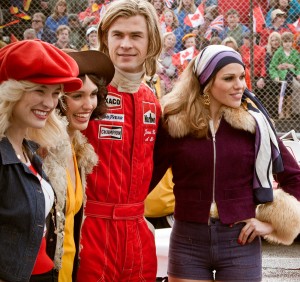Rush provides high-octane thrill ride
The concept for Rush is immediately intriguing: a dramatic movie about racecar drivers. Directed by Ron Howard, it seemed the film would look away from the recent focus of car-heavy films such as The Fast and the Furious and instead focus on the psychologies and personal lives of the drivers putting themselves at risk by driving cars in a circle at 170 miles per hour for a living. It certainly focuses on this aspect just as much as, if not more than, the races themselves, and it would have been difficult to find a story in driving history more suited for this purpose.

Crossing the finish line · The Ron Howard-directed Rush takes a different approach to the racing film genre, choosing to emphasize the psychology behind Formula 1 drivers while also including thrilling racing scenes. – Courtesy of NBC Universal
Based on a true story surrounding the 1976 Formula 1 season, the film focuses on the rivalry between two of the sport’s then pre-eminent drivers: James Hunt and Niki Lauda. Hunt is a brash, womanizing Englishman played by Chris Hemsworth, and Lauda is a pragmatic and blunt Austrian driver played by Daniel Brühl. The audience sees their rise from ambitious young drivers on the Formula 3 circuit up to a contentious battle for the 1976 World Championship. Hunt is full of joie de vivre and daring, regularly risking his life for the chance to win. His character embodies the epitome of the movie super-driver. Lauda, on the other hand, says in the film that he’d be doing something else if he could make more money at it. He is all business all the time at the expense of any risk-taking or social courtesies. These character traits are bent in the pursuit of beating one another.
Hemsworth, best known for his turn as Thor in The Avengers, graces most of the movie’s publicity material. His character’s playboy antics only shine a light on his undeniable movie-star appeal. Hemsworth shows off acting chops he hasn’t really needed before as his character Hunt begins to struggle to maintain relationships and the pressure to keep up with the metronomic and relentless Lauda. And while Hunt spends most of the film frolicking with beautiful women and drinking, the character has a certain amount of complexity — and Hemsworth’s portrayal doesn’t disappoint.
The role of Lauda is trickier. The Austrian is prickly and the accident leaves him scarred. Brühl is the much more established actor in terms of dramatic roles and handles the job very well. His attempts to replicate Lauda’s Austrian accent, however, are a bit jarring. Brühl is German but can speak English quite well. Unfortunately, the accent makes his speech come out robotic at times, and it overshadows other great aspects of his performance.
For a film so focused on what happens off the track, it certainly managed to pack a lot of punch whenever it actually got to the races. The film uses original camera placements, visual effects and sharp editing to give a racing experience that is very different from the car-centric films that seem to grow more stale with every sequel. Every shot seems doubly intended to recreate both the exhilaration of going at intense speeds and the sobering reality of how quick a driver’s reaction time has to be to pull it off. The shaking, swerving and, most of all, blurring that occurs as drivers evade walls and other “bombs on wheels,” as the film calls them, is equal parts terrifying and exciting.
Seen on the big screen, the racing scenes are enthralling, especially when they are given extended time as opposed to the slightly dissatisfying race snippets that occupy most of the movie. It would be very interesting to see what Howard and cinematographer Anthony Dod Mantle would do with a film focused more on the driving itself, as these scenes would not only not feel out of place in a more action-focused car movie, but would provide more thrills than the tired car chases that have become a staple of action cinema.
But it’s certainly understandable why Howard used so few of these scenes. Rush favors focusing on the drivers over the driving, and there’s a constant comparison and contrast between the two main characters. The film’s comparatively framed narrative is elegantly done, and manages to draw out the spirit of competition and also delve into the psychology of competitors simultaneously.
One major misstep comes after the climax of the movie. There is a scene where the two protagonists run into each other and essentially sum up the characters’ differences, and what one learned about the other. Frankly, this is rather clumsy way to end the movie — for a film that worked so hard to show the lives of these characters, having them come out and tell us the point of the movie was more than a bit awkward.
Aside from the ending, Rush was great at what it set out to do. It gave a glimpse into the psyches of these two very connected rivals while capitalizing on the excitement and drama that a Formula 1 movie has the potential for. And for viewers who are expecting an octane-filled adrenaline fest and a thought-provoking thriller, Rush ultimately crosses the finish line.
